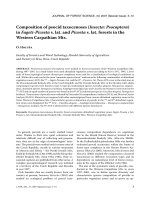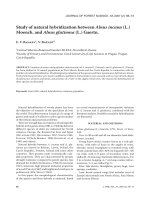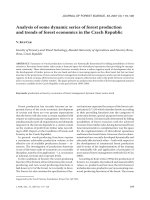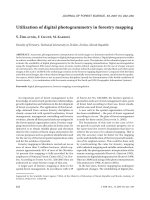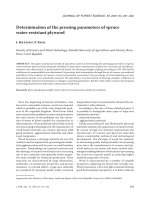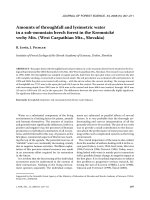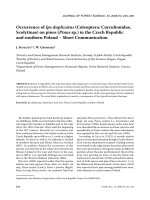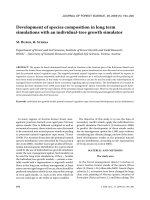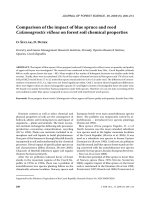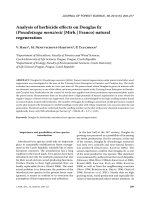Báo cáo lâm nghiệp: "Utilization of digital photogrammetry in forestry mapping" docx
Bạn đang xem bản rút gọn của tài liệu. Xem và tải ngay bản đầy đủ của tài liệu tại đây (489.31 KB, 9 trang )
222 J. FOR. SCI., 53, 2007 (5): 222–230
JOURNAL OF FOREST SCIENCE, 53, 2007 (5): 222–230
An important part of forest management is the
knowledge of natural and production relationships,
growth regularities and relations in the development
of forest ecosystems. e application of this knowl-
edge obtained from various forestry disciplines is
closely connected with spatial localization. Forest
management, management controlling and forestry
evidence, almost all their partial tasks are assigned to
the forest spatial organization units. Forestry map-
ping ensures their exact allocation in forest areas. Its
objective is to obtain reliable planar and elevation
data for the creation of forest maps and projects for
various purposes such as position identification and
for the survey of the forest spatial organization units
and for the evidence of parcels.
Forestry mapping in Slovakia is carried out on an
area of more than 2 million hectares, which rep-
resents approximately 41% of area of the Slovakia.
At present this mapping is fully provided by the
employees of National Forest Centre (NLC) in Zvo-
len. According to Forest Act No. 326/2005 they are
authorized to create forestry maps of this area.
A larger part of forestry mapping is done in the
spatial forest management. In accordance with § 39
of Forest Act No. 326/2005, the forestry spatial or-
ganization units are: forest management units, parts
of forest land according to their use, forest stands,
partial areas and forest stand groups.
A new unit in the spatial organization of forests
has been established – the part of forest organized
according to its use. e plan of forest management
is made for these units (Ž A. 2005).
e boundaries of this unit in the case of for-
est parcels in private and common property are at
the same time the owner’s boundaries that have to
achieve the accuracy for cadastral mapping. at is
why the accuracy must be better for the mapping
works and identification of the forest parcel bounda-
ries of its original owners. is could be done only
by synchronizing the rules for forestry mapping
with cadastral mapping and suitable rationalization,
especially the photogrammetric interpretation of the
remote sensing materials (B, G 1995),
transition to digital photogrammetry (B 1998;
H 2000) and using of the photo interpretation
(H 1996; A 2001).
In the last years, forestry mapping has undergone
significant changes. e establishing of digital pho-
Supported by the Scientific Grant Agency VEGA of the Ministry of Education of Slovak Republic and Slovak Academy of
Sciences, Project No. 1/3525/06.
Utilization of digital photogrammetry in forestry mapping
Š. Ž, F. C, M. K
Faculty of Forestry, Technical University in Zvolen, Zvolen, Slovak Republic
ABSTRACT: At present, photogrammetric interpretation of aerial images is a dominant method of forestry mapping.
In the last years, transition from analogue to digital photogrammetry has been distinct. Digital photogrammetry enables
to achieve workflow effectivity, and so to decrease the final product costs. e objective of the submitted paper was to
evaluate the availability of digital photogrammetry for the forestry mapping rationalization. Digital aerotriangulation
using the ImageStation SSK system brings more accurate results without requirements for the use of a larger amount
of control points. e results also demonstrated the use of colour infrared aerial images, and also black and white aerial
images at the scale 1:15,000 for the orthoimage creation in the forestry mapping department. Compared with the black
and white aerial images, the colour infrared images have an essentially more interesting content, mainly from the qualita-
tive aspect, which shifts them to use in many forestry disciplines (mostly for determination of the health conditions of
forests stands, ), in combination with the remote sensing of the Earth and GIS (Geographic Information Systems).
Keywords: digital photogrammetry; forestry mapping; aerotriangulation
J. FOR. SCI., 53, 2007 (5): 222–230 223
togrammetry as a method for the digital aerial image
interpretation and a wide range of Global Position
System methods (GPS) for terrestrial measurements
enhanced forestry mapping to a qualitatively higher
level. New knowledge from the remote sensing of the
Earth and Geographic Information Systems (GIS)
also enable higher rationalization of mapping work
in forestry.
Digital photogrammetry represents a computer-
supported technology of photogrammetric data
processing and the computer must be equipped with
powerful hardware and special photogrammetric
software.
In this context the basic digital forest map is cre-
ated today and in the forefront is the transforma-
tion of basic forest maps from an analogue form
to a digital form. Progress in this sphere is fast and
every year new modern products are developed that
become more accessible, products with better accu-
racy, faster, but mainly processing input data more
reliably and giving higher-quality outputs.
e objective of the submitted paper is to evaluate
the availability of digital photogrammetry for the
forestry mapping rationalization.
Digital photogrammetry in forestry mapping
Digital photogrammetry is a process of digital
image interpretation in a computer without human
assistance. Digital image is obtained by primary
digitizing straight from a digital camera or by sec-
ondary digitizing – scanning of the aerial image.
e information obtained in this way is called a
record. e record is composed of a set of image
units (pixels), the position of which is determined
by their reference to the concrete row and column
of the image matrix and the intensity of each image
unit corresponds with the average brightness value
or radiation that is electronically measured on the
matching area in the field or with the secondary
digitizing on the aerial image.
Transition from analogue to digital photogram-
metry is inhibited the use of the other photogram-
metric devices and all processing computers.
Known algorithms have been implemented to
solve the problems of classic photogrammetry
such as triangulation, aerial image orientation,
orthoprojection, stereoscopic measurement. Dig-
ital photogrammetry includes some methods for
image processing and computer vision, e.g. filter-
ing, sharpening, contrast changing. Algorithms
for image comparison can be used with automatic
orientation of aerial images, triangulation, manual,
half-automatic, automatic digital terrain model ge-
neration. A digital photogrammetric system should
include these modules:
– Import of scanned aerial images and data from
GIS/CAD,
– Modification of the image radiometric attributes
(filtering, contrast changing),
– Mono and stereo image interpretation,
– Photogrammetric data collection (aero triangula-
tion, mono, stereo measurement),
– DTM processing (automatic generation, display-
ing, editing),
– Automatic modules (image comparison, image
classification),
– Image transformation (planar, epipolar, ortho-
photo generation).
Development of digital photogrammetry takes
place together with development of the remote
sensing of the Earth. Photogrammetry and remote
sensing of the Earth are overlapping each other,
photogrammetry is the science about position de-
termination, dimensions, shapes of features situ-
ated on the Earth relief (forest area), remote sensing
researches mostly the qualitative aspects of features
(e.g. damage to the forest stands).
At the beginning of the 90’s, forestry mapping
changed from the analogue making of the maps with
thematic forestry themes into a system, the output
of which is a digital forestry map. Financial condi-
tions and hardware equipment (Stereometrograph
– Lesoprojekt, Topocart D – Technical University in
Zvolen) did not solve this problem complexly. Sen-
sors for coordinate reading and their processing by
the specialized software products (STEREOFOTO,
MAPGEN – MDL application for Microstation)
were added to some of those equipments. Testing the
system Digital Video Plotter (DVP) did not bring the
expected results although the attained accuracy of
point position was quite good. However, other meth-
ods how to achieve the goal were searched, including
the testing of digital interpretation methods of aerial
images and various other photogrammetric mate-
rials, such as black and white aerial images (mul-
tispectral, colour infrared aerial images) with the
support of specialized software products (TOPOL,
EASY/PACE, ORTHOENGINE, ), and a technique
was selected of continuous map vectorization with
digitizers, later by the ON SCREEN method, which
partly works at present.
From two main solutions (transition to ana-
lytic photogrammetry and from it to digital pho-
togrammetry, or straight from analogue to digital
photogrammetry), based on the skills of digital pho-
togrammetry operators (GEODIS, s. r. o., Brno,
EUROSENSE, s. r. o., Bratislava, VTÚ Banská Bystri-
224 J. FOR. SCI., 53, 2007 (5): 222–230
ca, ) and research (Technical University in Zvolen,
Department of Forest Management and Geodesy), a
technique of the mapping by digital image processing
at the Department of Forestry and Photogrammetry
was selected, thus transformation straight from ana-
logue to digital photogrammetry.
e basic operating system is Windows NT and
XP Professional. Specialized photogrammetric
software ImageStation SSK is solved modularly and
it contains: Microstation SE/J, ImageStation Feature
Collection, ImageStation DTM Collection, Image-
Station Stereo Display, ImageStation Automatic
Elevations, ImageStation Ortho Pro and Geomedia
Professional.
Facing these new technical challenges Z/I Imaging,
as a photogrammetry system provider, has recently
upgraded and enhanced its existing automatic trian-
gulation system. Special emphasis has been given to
the Image Station Automatic Triangulation (ISAT)
user friendliness, reliability, and integration. Some
of the main features of the ISAT are: automatic and
manual interior and relative orientation, semi-au-
tomatic and manual tie point measurement, bundle
block adjustment and so on (M, M
2001).
In 2003 forestry mapping was done of appro-
ximately 199,800 ha of the forest land, of that
120,000 ha with digital and 79,800 ha with analogue
technology.
Mapping in 2004 was performed approximately on
the area of 188,700 ha, reambulation on 83,100 ha,
and new mapping on 105,600 ha of the forest land.
Expected advance of the digital photogrammetric
mapping technology secured the processing of
70–80% of the mapped area. Saved capacities were
used mainly for measurements of the forestry detail
not visible on the aerial images and increased the
production of digital orthomaps.
In 2006 we expect a progressive increase of the
digital mapping technology to 100% of the mapped
area.
e results confirm the correctness of the fast
transition from analogue to digital photogrammetry
in regard to forestry mapping.
Forestry mapping is included by its character in the
thematic purpose mapping. is mapping is char-
acterized by its requirement for an appropriate car-
tographic accuracy and requirement for displaying
various specialized forestry features (classical black
and white aerial images offer only few possibilities).
We can see from the results that the colour infrared
images at the scale 1:15,000 could be used for com-
pleting the planimetry within the reambulation of
forest maps or digital forest maps in the 5
th
class for
the forestry mapping accuracy. ese materials are
suitable as a supplement to classical black and white
images (there are indications that they could substi-
tute them). From the results of the digital automatic
aero triangulation at the aerial images at the scale of
1:15,000 we can say that in the planar accuracy they
match the 4
th
class of cadastral mapping. Based on
the results from aerial images at the average scale
1:16,000 we can say that images scanned with the
resolution 1,700 DPI are more suitable for cadastral
mapping, besides images with the resolution 850 DPI.
From the forestry mapping aspect, the results fully
comply with the 5
th
class and in the case of images
scanned at 1,700 DPI with the 4
th
class of the ac-
curacy. Attaining the 4
th
class of the accuracy fully
meets the requirements for the determination of the
customer unit boundaries, which represent owner
boundaries from the aspect of forest spatial organi-
zation (Ž Š., C 2002).
The use of digital photogrammetry in forestry
practice points to a larger use of the information
displayed on classical black and white aerial images,
and also on the other accessible materials, such as
colour, colour infrared or multispectral ones where
the specialized forestry information is more visible.
MATERIAL AND METHODS
Experimental material contains data obtained
from a terrestrial measurement and data obtained
from aerial images. Forest maps and forest manage-
ment plan from the area of interest were used at the
same time.
Material from terrestrial measurement
Control points
e points were taken from the measurement and
interpretation of aerial images, for the signalization
of the control points crosses from the white PVC foil
were used. Material from a terrestrial measurement
was obtained by the tachymetric measurement in the
area of the University Forest Enterprise. e meas-
urement was realized with an electronic tachymeter
ELTA 4, using methods of the polygonal courses and
with connection to the existing geodetic network
and the accuracy m
d
= ± 3–6 mm. e measurement
of the control points with the tachymeter ELTA 4
meets the requirements for the 2
nd
class of accuracy
for mapping according to the standard STN 01 3410
(T 1998). In areas with bad connection to the
geodetic network we used a GPS receiver TURBO
– S II with the static method of measurement and
the 2
nd
class of accuracy for mapping.
J. FOR. SCI., 53, 2007 (5): 222–230 225
Table 1. e coordinates of control points from the terrestrial measurement
Number Y (m) X (m) Z (m) Characteristic
1 423,081.663 1239,568.518 416,438 pole
2 423,108.902 1239,589.325 418,122 pole
3 423,141.461 1239,614.005 419,436 pole
4 423,174.705 1239,638.809 421,165 pole
5 423,207.215 1239,662.754 421,399 pole
6 423,240.643 1239,687.625 421,540 pole
7 423,270.925 1239,710.118 422,241 pole
8 423,301.924 1239,733.206 422,626 pole
9 423,336.701 1239,758.851 423,200 pole
10 423,367.949 1239,782.257 423,258 pole
11 423,451.583 1239,855.835 422,259 bush at the top
12 423,464.299 1239,835.334 426,197 birch at the top
15 423,505.552 1239,832.186 420,034 bush at the top
17 423,525.994 1239,787.062 421,075 pine at the top
19 423,506.221 1239,748.224 428,043 bush at the top
21 423,365.352 1239,725.756 429,772 pear at the top
23 423,348.638 1239,700.175 434,580 bush at the top
25 423,397.264 1239,804.531 423,635 pole
26 423,430.718 1239,829.602 422,093 pole
30 423,262.303 1239,380.890 439,316 spruce at the top
32 423,193.257 1239,349.633 423,441 bush at the top
34 423,174.863 1239,339.425 426,129 hornbeam at the top
36 423,114.254 1239,387.100 421,428 bush at the top
38 423,076.803 1239,385.550 423,873 pine at the top
48 423,051.492 1239,545.265 413,506 pole
51 423,007.228 1239,342.486 427,265 bush at the top
53 422,956.263 1239,374.808 427,473 corner of the sluice
60 422,880.402 1239,393.567 426,998 corner of the sluice
64 422,843.624 1239,410.458 424,767 corner of the crossroads
65 422,848.614 1239,413.920 427,099 bush at the top
67 422,788.169 1239,426.695 419,289 corner of the crossroads
68 422,912.501 1238,949.492 453,121 bush at the top
71 422,735.031 1239,128.044 415,746 bush at the top
73 422,585.754 1239,218.931 407,215 bush at the top
75 422,538.486 1239,264.039 395,652 spruce at the ground
76 422,639.820 1238,773.550 419,610 front of the roof
79 422,607.079 1238,693.160 431,916 range row 1
81 422,634.860 1238,659.694 433,202 range row 1
82 422,674.364 1238,683.373 433,164 range row 2
84 422,564.226 1239,480.127 407,831 bush at the top
86 422,551.503 1239,492.047 407,811 bush at the top
226 J. FOR. SCI., 53, 2007 (5): 222–230
Measured data were transformed into the coordi-
nate system S-JTSK.
Check points
In the area of interest 41 check points were select-
ed. Trees, bushes, sluices, crossroads, poles, building
corners etc. were used as the measurement points in
landscape (Table 1).
To determine the position and elevation accuracy
of the digital photogrammetric interpretation of
black and white and spectrozonal aerial images,
modules for the stereo interpretation in the Imag-
eStation environment were used.
Aerial images
Diapositive black and white aerial images:
Scale 1:15,000
Characteristic: panchromatic materials receive
rays from the whole visible spectrum (400–700 nm).
ey are used most frequently in the aerial scanning.
ey enable to create the stereo image, interpreta-
tion of planimetry and hypsometry, recognition of
each kind of features.
Diapositive spectrozonal aerial images:
Scale 1:15,000
Characteristic: spectrozonal or FALSE COLOUR
aerial images, output image is different from real
colours. e first layer is panchromatic (sensitive
in the wavelength range of 520–720 nm) followed
by the infrared layer (with sensitivity in the range
720–800 nm). After developing them, the image on
the panchromatic layer displays purple colour and
on the infrared layer green. is composition is char-
acteristic of the spectrozonal aerial images. When
needed a three-layer material can be used.
Aerial images were scanned with the LMK 15 ca-
mera. Its focal length was 152 mm.
Aerial image interpretation using
the ImageStation SSK system
System description
e system ImageStation SSK was used for the
photogrammetric interpretation of aerial images
and for their planimetry and elevation accuracy
determination. e main working absolute and rela-
tive orientation was processed in the ImageStation
Model Setup (ISMS), using 5 control points for each
image pair (black and white, infrared). e module
ImageStation Stereo Display enabled their stereo
displaying, coordinate readout, as well as bright and
contrast correction in the case of the bad resolution
of objects. Stereo glasses with the infrared emittor
and pointing device were used for the interpretation,
as well as stereo zoom, stereo displaying and move-
ment over the stereo model. Measured data were
saved to a database. For the infrared and black and
white image pair the coordinates (X, Y, Z) were read
out at 41 check points only once.
Digital aerotriangulation
After aerotriangulation ISAT automatically gener-
ates computed coordinates at the check points, so
it is possible to statistically evaluate their accuracy.
ese check points are imported and edited with the
control points, but with the check point attributes
given. So they do not enter into the computing but
serve for the accuracy verification. ey can also
be used for densification or as detailed points. If
there are no such points imported before, their
coordinates can also be determined in the software
product (ISSD), by measuring with the stereo cursor.
Schematic workflow is displayed in Fig. 1.
To check the digital block aerotriangulation ac-
curacy in relation to the number of control points
used two series of projects were created with dif-
ferent placement of control points in the block and
Table 2. Control points used in project No. 1
Point
number
Y (m) X (m) Z (m)
1 423,191.860 1234,542.780 568,140
2 427,232.580 1234,527.220 878,840
3 424,520.840 1242,953.450 397,190
4 424,725.590 1241,508.500 396,420
5 424,684.460 1236,722.510 651,760
6 427,755.860 1244,362.400 480,270
7 428,401.110 1237,998.340 807,930
8 429,878.840 1239,416.780 809,300
9 430,600.090 1243,450.670 599,120
305910 418,718.930 1241,236.370 299,140
405910 415,820.090 1241,210.780 469,510
505910 419,592.970 1243,996.460 353,660
805920 433,084.780 1242,412.880 498,970
905915 424,448.820 1243,545.820 416,600
1505910 416,636.780 1246,013.730 349,350
1805910 414,657.760 1247,460.670 325,670
2205914 421,603.700 1238,668.570 400,880
2305914 422,850.100 1239,287.400 437,320
2405909 418,160.930 1238,203.060 309,040
2605909 412,991.420 1238,691.140 439,360
2705909 419,995.110 1239,108.700 319,850
2805909 417,979.390 1239,827.420 304,380
J. FOR. SCI., 53, 2007 (5): 222–230 227
with various number of check points. e first set
was composed of projects number 1, 2, 3, and 4,
the second set of projects number 5, 6, 7, and 8. All
projects were situated in area of the University For-
est Enterprise in Zvolen. 88 aerial images were used
in each project aligned in 7 rows. We tried to keep
the basic principles of control point selection, such
as their uniform distribution in the block of aerial
images (planar and vertical because of the vertical
diversity of the area) and their good position for the
identification. To show the control point distribution
project number one was selected (Table 2, Fig. 2.)
Stereo interpretation
For the planar and elevation accuracy determination
of the digital photogrammetric interpretation of aerial
images, modules for the stereo interpretation (ISSD)
were used, applying the special stereo glasses with the
infrared emittor and positioner. Each image pair did
relative and absolute orientation with the same control
points used. Coordinates X, Y, Z were acquired from
the stereo model at 41 check points for the black and
white and infrared images. On the same area, stereo
models were generated, from them DTM’s and finally
orthophotos on two various terrains using the modules
ISDC, ISAE, ISBR. e areas (12 overlapped areas)
were chosen according to the terrain variability and
crop density. e first type was characterized by the
flat terrain and it was mostly without forests (area
No. 1), the second was situated in the mountainous
terrain and in the area with high crop density (area No.
2). Two series of projects were also created. For each
area in the first series DTM was generated automati-
cally. In the second series 25 control points were used
and for both areas DTM was generated automatically
and manually and then orthophotos were created.
Finally six projects were created.
Fig. 1. Software ISAT workflow
Fig. 2. Distribution of the control
points in project No. 1
228 J. FOR. SCI., 53, 2007 (5): 222–230
RESULTS AND DISCUSSION
Automatic digital aerotriangulation executed by
the module ISAT automatically generates computed
coordinates on the control points and so we can sta-
tistically evaluate the accuracy of aerotriangulation.
ese points have the check attribute, so they do not
enter into the computing, but they serve as check up
for accuracy. To evaluate the accuracy of the final
orthophoto could be used comparison between the
point coordinates readout from orthophoto with the
coordinates of the same points, which were measured
terrestrially by the GPS, or electronic tachymetre, or
taken from the cadastre as trigonometric points. For
the accuracy determination of stereo interpretation
the coordinates of well identified points (features)
on the aerial image and terrain were used. e co-
ordinates of these points measured by terrestrial
methods were taken as accurate.
In general eight projects were created in two in-
dependent series in relation to the number and dis-
tribution of control points. In the fifth project after
its connection into the master project, 6 images did
not connect into the block. ese aerial images were
connected manually, step by step on each image by
identifying tie points. ose were defined not only
on the unconnected images, but also on the nearest
two images around those unconnected ones. After
defining all the points the calculation of the whole
block must be run once more. e calculation of
the block is time consuming and so we premised
that the same error would be generated on the other
projects, so these relative points in the next projects
(6, 7, 8) were defined before starting the calculation
of the block.
To determine the planimetry and elevation accu-
racy on the aerial images the ImageStation environ-
ment was used, especially the module ImageStation
Stereo Display (ISSD) and ImageStation Model
Setup. Stereo glasses with the infrared emittor were
used for the evaluation.
For the stereo evaluation and comparison models
were created from the blocks where 6 and 22 control
points were used for the orientation.
e accuracy of the planar point fields is evaluated
by the basic coordinate error mxy and the accuracy
of the elevation point fields by the basic coordinate
error m
H
. ese cannot exceed the values of the
allowed errors u
xy
, u
v
and u
H
. For each class of the
mapping accuracy according to the standard STN
01 3410 the large scale maps are presented in Table 3.
Comparing the results achieved in each project,
we can see that from the digital automatic aerotri-
angulation aspect, the number of the used control
points is not significant for the new point position
determination accuracy (Table 4). Mean position
error values were in the range from 0.20 to 0.28 m.
Comparison of the results with the standard STN
01 3410 (Table 3) show that each project except
project No. 5 did not exceed allowed deviation of
the mean position error for the 4
th
class of accuracy.
Although this value was exceeded in the 5
th
project
(m
xy
= 0.276 m), it was only 0.016 m, which is nearly
to the bottom interval for the 5
th
accuracy class.
ere is a visible variability between the first and
the fourth project, i.e. between the projects with
Table 3. Accuracy criteria according to the standard STN
01 3410
Accuracy classes u
xy
(m) u
v
u
H
(m)
1
st
class 0.04 0.03 0.30
2
nd
class 0.08 0.07 0.40
3
rd
class 0.14 0.12 0.50
4
th
class 0.26 0.18 0.80
5
th
class 0.50 0.35 1.50
Table 4. Results organized according to the number of control points used in the projects
Aerotriangulation accuracy Orthophoto accuracy mxy
m
x
m
v
m
z
m
xy
area No. 1 area No. 2
Project 1 0.2717 0.2429 0.6457 0.2577 0.9087 0.7008
Project 8 0.2015 0.1985 0.5103 0.2000 – –
Project 2 0.2908 0.2384 0.6417 0.2659 11.6960 0.9429
Project 7 0.2103 0.2095 0.5522 0.2100 – –
Project 3 0.2516 0.2322 0.6803 0.2421 – 15.8450
Project 6 0.2167 0.2216 0.6032 0.2190 – –
Project 5 0.2733 0.2792 0.7072 0.2760 – –
Project 4 0.2125 0.2305 0.8227 0.2217 0.3545 0.8470
DMT-auto. – – – – 0.5664 0.7075
DMT-man. – – – – 0.4069 0.5494
J. FOR. SCI., 53, 2007 (5): 222–230 229
the highest and the lowest number of control points
from the aspect of height determination accuracy.
e results on the final orthophotos and comparison
with STN (Table 3) show that projects No. 1–3 and
project No. 4 (mountainous country region) exceed-
ed allowed deviation for the mean position error for
the 5
th
accuracy class. Comparing with the thematic
forestry mapping we may get acceptable results. In
project No. 4 situated on the flat area 0.35m accuracy
was reached, which corresponds to the 5
th
accuracy
class. is project has the lowest number of control
points and the greatest elevation determination error
so it should have an influence on DTM accuracy and
orthophoto accuracy. But we can premise that this
error was not shown at the flat country projects. e
orthophoto generated from the mountainous area
was the second most accurate instead of project No. 3,
where 11 control points were used and where the
accuracy is rapidly decreasing.
According to the forest management workflow
forest thematic mapping belongs to the 5
th
accuracy
class. ese boundaries were accomplished in the
projects. Digital stereo interpretation was compared
with the classical analogue methods and the results
are described in detail in the work (T,
K 2004) (Table 5).
ese results show that the digital photogram-
metric method is more accurate than the analogue
processing at the given positions. e m
z
error and
the m
xy
error at the black and white and colour in-
frared images are reciprocally comparable. From
the above mentioned we can say that the colour
infrared images are suitable for the forestry mapping
purposes, so it is convenient to replace presently
used black and white photos with the infrared ones,
despite of their higher costs. ese aerial images are
suitable for the forest state determination (health
conditions mapping, remote sensing ) not only for
forestry mapping.
CONCLUSIONS
Digital photogrammetry enables to increase work
effectivity, and so to decrease the final product costs.
is is also influenced by a decrease in the cost of
hardware equipment. Operators need not have so
detailed knowledge of the computer technologies, so
it has more users from the public. It brings us new
possibilities in the digital image processing and ma-
nipulation, such as with digitized aerial images, with
the creation of orthophotomaps and their qualitative
interpretation. Automation affects and simplifies
the mapping workflow, which has been very time
consuming till now. Digitized aerial images from the
analogue aerial cameras offer image information at
the high geometric resolution 10–15 µm. In future
they will be substituted with digital image data ob-
tained with digital cameras.
Digital image processing at the scale of 1:15,000
achieved really good results at the workstation,
but higher quality can be achieved only through
transition to larger scales – 1:10,000 (mainly for the
cadastral mapping) and point elevation accuracy. It
relates with higher economic difficulty for obtaining
such images, because it increases their number in
the block. e number of control points used in the
block does not have an expressive influence on the
images processed at the given scales. An economic
analysis for the quantification of those methods
should be done.
In the forested areas the signalized points are not
visible enough at all the images. It is necessary to
synchronize signalization with the aerial scanning of
the area. In the analogue scanning of images control
points visible at the aerial images were scanned at
first and then they were determined and measured.
e onset of digital photogrammetry and automatic
triangulation makes the analogue methods applica-
ble only in exceptional cases.
e results regarded the utilization of colour in-
frared (spectrozonal), black and white aerial images
at the scale of 1:15,000 for the stereo interpretation
and forestry mapping. It shows that by the help of
stereo interpretation “on screen” it is possible to
achieve more accurate determination of new detailed
points, as on the orthophoto created from a stereo
image pair. Digital stereo interpretation represents a
fast and useful tool for forestry mapping, especially
for the planimetry and hypsometry creation and
reambulation.
In comparison with the black and white images, the
colour infrared ones have more abundant content so
Table 5. Comparison of the analogue and digital method; final values of the mean position error (m
xy
) and mean height
error (m
z
)
Black and white images Colour infrared images
m
xy
m
z
m
xy
m
z
TOPOCARD D 0.623 0.712 0.521 0.325
ImageStation 0.376 0.275 0.374 0.338
230 J. FOR. SCI., 53, 2007 (5): 222–230
they are predetermined to be used in various forestry
disciplines (health condition determination, ) in
regard to the remote sensing of the Earth and GIS.
From the orthophoto accuracy aspect gener-
ated DTM have the great influence. Precise DTM
need to be corrected (edited), because they contain
points that software marks with various levels of
redundancy. However the achieved results are suit-
able for forestry mapping, there is a requirement for
checking the dependence of the final orthophoto ac-
curacy from a DTM grid width and from the edited
automatically generated points with redundancy
because manual generation of DTM is more time
consuming.
Refe rence s
ALBERTZ J., 2001. Einführung in die Fernerkundung. Darm-
stadt, Wissenschaftliche Buchgesselschaft: 250.
BARTOŠ P., 1998. Digitálna fotogrametria, jej možnosti
a perspektívy. In: Geoinformatika v službách armády
Slovenskej republiky. Banská Bystrica, Topografický ústav
Armády SR: 29–41.
BARTOŠ P., GREGOR V., 1995. Aplikácie digitálnej foto-
grametrie pri dokumentácii pamiatok. Geodetický a kar-
tografický obzor, 12: 261–265.
HILDEBRANDT G., 1996. Fernerkundung und Luftbildmes-
sung. Heidelberg, Wichman: 676.
HRICKO B., 2000. Presnosť digitálnej jednosnímkovej foto-
grametrie a jej možnosti využitia v lesníckom mapovaní.
In: Aplikácia DPZ v lesníctve. Zvolen, TU: 215–224.
MADANI M., MOSTAFA M., 2001. ISAT direct exterior
orientation QA/QC strategy using POS data. In: OEEPE
Workshop Integrated Sensor Orientation. University of
Hannover, Institute for Photogrammetry and Geoinforma-
tion (IPI): 17.
TOMAŠTÍK J., KARDOŠ M., 2004. Nové perspektívy využitia
farebných infračervených leteckých meračských snímok
v lesníckom mapovaní. In: Aktuálne problémy lesníckeho
mapovania. Zvolen, TU: 98–104.
TUNÁK D., 1998. Určovanie polohových bodov v zalesnených
územiach metódou polygónových ťahov. In: Aktuálne pro-
blémy lesníckeho mapovania. Zvolen, TU: 127–135.
ŽÍHLAVNÍK A., 2005. Hospodárska úprava lesov. [VŠ učeb-
nica.] Zvolen, TU: 388.
ŽÍHLAVNÍK Š., CHUDÝ F., 2002. Možnosti využitia leteckých
farebných infračervených snímok pri lesníckom mapovaní
– Die Möglichkeiten der Ausnutzung der Color – Infrarot
– Luftmessbilder bei der Forstlichen Kartierung. Zvolen,
TU: 53.
STN 01 3410. Mapy veľkých mierok. Základné ustanovenia.
Zákon NR SR č. 255/2001 Z.z., ktorým sa mení a dopĺňa zákon NR
SR č. 162/1995 Z.z. o katastri nehnuteľností a o zápise vlastníc-
kych a iných práv k nehnuteľnostiam (katastrálny zákon).
Zákon NR SR č. 326/2003 Z.z. o lesoch.
Received for publication August 8, 2006
Accepted after corrections January 26, 2007
Využitie digitálnej fotogrametrie v lesníckom mapovaní
ABSTRAKT: Fotogrametrické vyhodnotenie leteckých snímok je v súčasnosti dominantnou metódou lesníckeho
mapovania. V posledných rokoch je jednoznačný prechod od analógovej ku digitálnej fotogrametrii. Digitálna
fotogrametria umožňuje zefektívnenie pracovného postupu a tým zníženie finálnych nákladov. Hlavným cieľom
príspevku bolo posúdiť vhodnosť digitálnej fotogrametrie pri racionalizácii lesníckeho mapovania. Digitálna aero-
triangulácia použitím systému ImageStation SSK prináša presnejšie výsledky bez potreby použitia veľkého množstva
vlícovacích bodov. Dosiahnuté výsledky tiež demonštrujú použitie farebných infračervených snímok, ale tiež čier-
no-bielych snímok s mierkou 1 : 15 000 pre tvorbu ortofotosnímok vhodných pre lesnícke mapovanie. Porovnaním
s čierno-bielymi snímkami farebné infračervené snímky majú bohatší obsah (hlavne z kvalitatívneho hľadiska), ktorý
ich posúva na použitie do mnohých lesníckych disciplín (najmä zisťovanie zdravotného stavu lesov …) v spojení
s diaľkovým prieskumom Zeme a GIS (geografickým informačným systémom).
Kľúčové slová: digitálna fotogrametria; lesnícke mapovanie; aerotriangulácia
Corresponding author:
Prof. Ing. Š Ž, CSc., Technická univerzita vo Zvolene, Lesnícka fakulta, T. G. Masaryka 24,
960 53 Zvolen, Slovenská republika
tel.: + 421 455 206 292, fax: + 421 455 332 654, e-mail:
